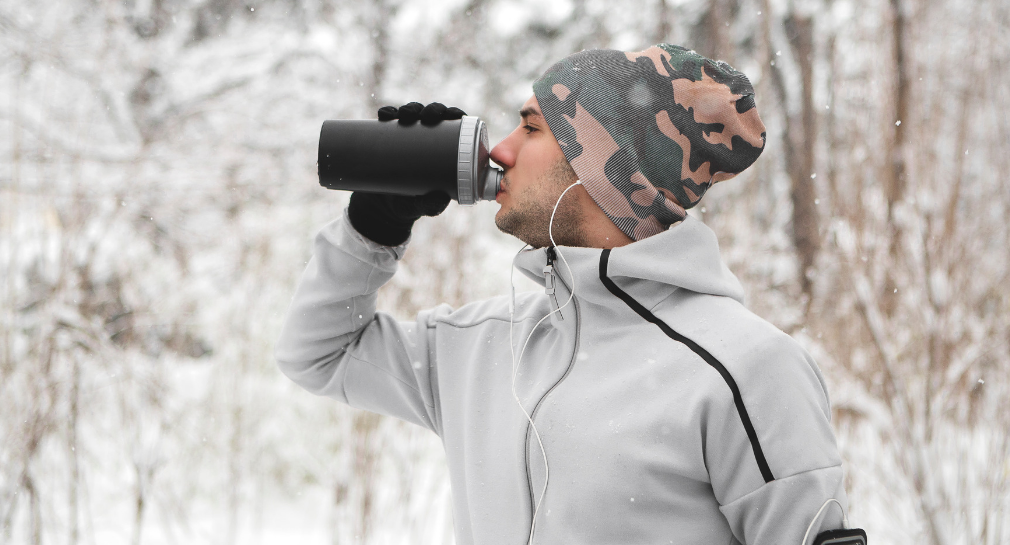When it’s 80-degrees and the sun is shining, it’s easy to remember to pack a bottle (or two) of water before heading out to get some exercise. When winter comes around, many of us put prioritize hats and gloves first (for obvious reason) and hydration ends up lower down on the priority list. And it makes sense: sweating is often less noticeable in the cold, and lower temperatures can actually reduce the body’s thirst response. However, staying hydrated in the winter is just as important as in the summer.
Dehydration in the Winter
While there are many reasons that risk of dehydration increases in cold weather, there are three main culprits.
The first is simply that sweat evaporates more rapidly in cold, dry air. Sweat evaporation means water loss, which if not replenished can lead to dehydration. For those of you getting your winter exercise on in the mountains, altitude leads to even greater evaporation.
The second reason has to do with all that winter gear keeping us warm. While it’s important to adequately protect the body against frostbite, how you layer up is key. As we add extra layers of clothing, we’re also adding more weight and thereby making the body work harder to move. This extra effort can lead to increased sweating and therefore extra moisture lost.
And depending on the type of material you’re wearing, this can become a vicious cycle as all that sweat can make our clothes cold and damp, requiring the body to work even harder to keep it warm. Give your body a hand by wearing light layers that wick away moisture. Synthetic fabrics, such as polypropylene, as well as natural fibers, like wool and silk, are your best bet for the layer closes to the skin. Despite being warm, avoid cotton as it absorbs water, which when next to your skin, can make you damp and cold.
Ever feel like you have to pee more often in the cold? Scientists have called this phenomenon “cold-induced diuresis”. Basically, cold weather leads to physiological changes that result in increased urination. And with more urination, there’s more water loss, which if not replenished, can lead to dehydration.
So what is this physiological process? Basically, when your body gets cold, your blood vessels constrict in order to keep blood flow concentrated around your vital organs and away from the skin. This results in increased blood pressure that in turn leads to more blood for the kidneys to filter. As the kidneys are working harder to filter the blood, they’re also producing more urine.
Signs of Dehydration
So how do you know if you’re becoming dehydrated? As many of us have probably heard many times: if you’re thirsty, you’re likely already dehydrated. But when our thirst signals aren’t working at full capacity due to the cold weather, there are other signs to lookout for. Some of the initial signs include:
- Dry, sticky mouth
- Dark urine color
- Fatigue
- Dry skin
- Headache
- Dizziness
- Constipation
More severe signs of dehydration include irritability or confusion, little-to-no urination and feeling feint or passing out when changing position (such as going from sitting to standing). If you or someone you’re with experiences any of these severe signs, seek immediate medical care.
Ways to Stay Hydrated in Winter
The key to avoiding dehydration is staying on top of your liquid intake. Just as you would in the summer, sip on fluids throughout the day – remember, feeling thirsty is often an early sign of dehydration. Here are a few key tips for staying hydrated in the winter:
- Drink hydrating fluids and foods throughout the day. This includes water, milk, fruits, and soups, just to name a few.
- Hold the ice. When the temperature drops, warm or room-temperature beverages will better maintain your optimal internal temperature.
- Be mindful to increase your water intake beyond what you normally drink when at altitude – I’m looking at you skiers and snowboarders.
- Save the alcohol for après ski. While a beer at lunch during a ski day can be tempting, alcohol has diuretic effects, increasing your risk for dehydration.
- As with any exercise lasting more than 1 hour, make sure to also replenish electrolytes and carbohydrates.
- Get cozy with hot cocoa. Just as chocolate milk is a good option for post-workout recovery, hot chocolate has a similar 3:1 carb to protein ratio plus will help keep your body warm (see tip #2). Just as with chocolate milk, keep an eye on how much sugar is in the hot chocolate you’re drinking.
How do you stay hydrated during your favorite winter activities? We’d love to hear! Leave us a comment below and don’t forget to track your fluid intake on the Lose It! App.

